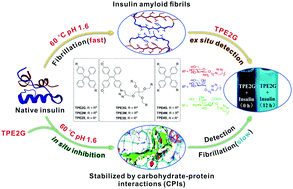Dual functional amphiphilic sugar-coated AIE-active fluorescent organic nanoparticles for the monitoring and inhibition of insulin amyloid fibrillation based on carbohydrate–protein interactions†
Abstract
Amyloid-related diseases, such as Alzheimer's disease, are all considered to be related to the deposition of amyloid fibrils in the body. Insulin is a protein hormone that easily undergoes aggregation and fibrillation to form more toxic amyloid-like fibrils. So far, it is still challenging to develop a new protocol to study the ex situ detection and in situ inhibition of amyloid fibrillation. Here, we reported a modular synthetic strategy to construct nine amphiphilic sugar-coated AIE-active fluorescent organic nanoparticles (FONs, TPE2/3/4X, X = G, M or S) with glucosamine (G), mannose (M) or sialic acid (S) as a hydrophilic moiety and tetraphenylethylene (TPE) as a hydrophobic AIE core. The carbohydrate–protein interactions between insulin and TPE2/3/4X were investigated by fluorescence spectroscopy, circular dichroism spectroscopy and transmission electron microscopy. Among the nine FON AIEgens, TPE2G was screened out as the best dual functional FON for the ex situ detection and in situ inhibition of the insulin fibrillation process, indicating that the glycosyl moiety exhibited a crucial effect on the detection/inhibition of insulin fibrillation. The molecular dynamics simulation results showed that the binding mechanism between TPE2G and native insulin was through weak interactions dominated by van der Waals interactions and supplemented by hydrogen bonding interactions to stabilize an α-helix of the insulin A chain, thereby inhibiting the insulin fibrillation process. This work provides a powerful protocol for the further research of amyloid-related diseases based on carbohydrate–protein interactions.



 Please wait while we load your content...
Please wait while we load your content...